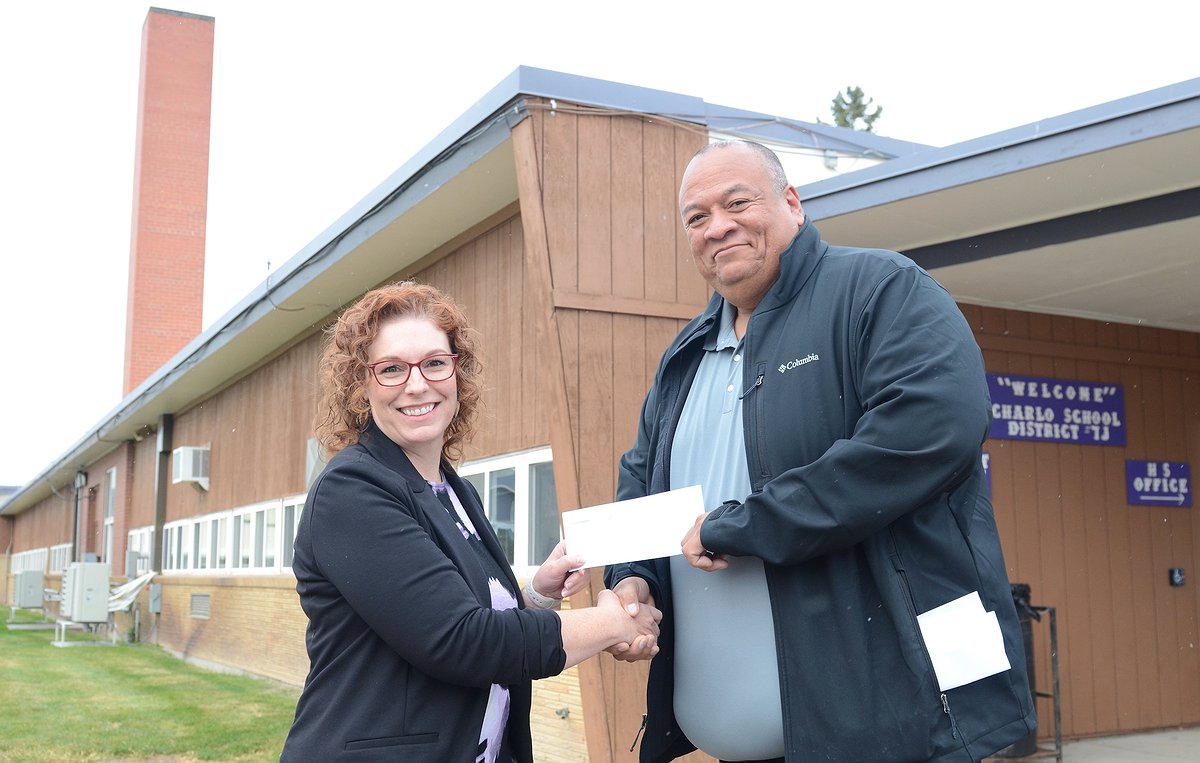Charlo saves money and kilowatts with HVAC upgrade
Charlo School District board member Daniel Cahoon remembers the good old days, when he used to descend “into the dungeon” below the high school to help janitor Pat Marmon keep the school’s ancient heating system alive.
“I remember the hum of everything, the smell of everything, and checking some weird random things,” he said of the World War II-era ship boiler that used to erratically heat the district’s four buildings.
“Now that it's gone, it's so much different down there, but it's so much better,” he said of the district’s new HVAC system. “It's been a huge blessing. It's just been amazing.”
Fellow trustee LaDonna Fryberger (without alluding to her age), added, “I've been out of school a long time and that same boiler was here when I was a kid.”
The two trustees were among a group that gathered last Thursday at the district office to celebrate the cost savings and improvements that have come with a new heating, cooling and ventilation system, with virtually no pain to local taxpayers.
Phase one of the project, which financed heat pumps in the high school and elementary building, was financed during the COVID pandemic with around $1.2 million from the federal Elementary and Secondary School Emergency Relief funds. The district also received a $1.2 million grant from the Department of Environmental Quality in 2022 – one of only 22 awarded nationwide – for phase two, which helped finance similar renovations in the junior high building and gym.
In addition, the district took out a 10-year loan from Glacier Bank to cover the remainder, which helped pay for such energy-efficient improvements as insulation, weather-stripping and LED light bulbs. The district’s energy savings are already helping pay back its loan.
That strategy was apparent at last Thursday’s meeting, when Mission Valley Power general manager Zachary Camel Conko presented district superintendent Teresa Weems with a check for $78,740 – the third installment in conservation rebates the district has earned this year. All told, MVP has paid the district $117,220 in the past six months for an estimated 422,450 kilowatts that were saved by the improvements.
“That’s enough energy to power more than 35 all-electric homes for one year,” Conko said.
At the same time, the district is saving an estimated $31,800 annually on energy costs by switching from diesel to an efficient electrical system. Those savings, in turn, will help pay off the money borrowed by the district to complete the project.
Lyle Neiss, who heads energy conservation for MVP, told the group that energy conservation is “the cheapest energy you can buy back.”
He noted that Bonneville Power Administration, which is where MVP purchases power for the Flathead Reservation, allocates around 2.75% annually for conservation, which gets returned to consumers in the form of rebates.
“By doing these kinds of projects, you help us achieve our conservation goal, and the region as a whole too,” Neiss said.
The stars aligned
Steve Love, who retired in June from his post as superintendent, worked closely with district clerk Sara Vaughan to pursue funding and complete the much-need improvements during his tenure.
“We had to do something because the boiler system we had was just an antique,” Love said. “It was the old style that heats the water, sends the water through the pipes. You'd hear banging and clanging – some days it would freeze, some days it was a sauna. It could be 20 below and we'd have the windows wide open because it was so inefficient.”
The federal ESSER funding, which could be used to improve school heating and ventilation systems, offered an opportunity they couldn’t pass up. “We were never going to get that much as a starting point again,” Love said.
Meanwhile, Vaughan had met representatives from Ameresco at a conference of district clerks and was impressed with their presentation. The district ended up hiring them for both phase one and two, and trustees and school staff expressed appreciation for the company’s guidance and work on the project.
“I just felt like with Ameresco, our school board, and the way our community attitudes and values are, this is something that I don't think anybody can argue with – spending and spending wisely,” Love said.
Weems, who stepped into Love’s shoes last summer, says the improvements have definitely boosted staff morale. “Finally getting air conditioning and everyone was like, ‘oh yes, this is so good,’” she said. She also lauded the support from Ameresco – “they’ve just led me through this” – as well as from Love, Vaughan and the rest of the staff.
Fryberger calls that cooperative atmosphere the “Viking village.”
“We have to invest in our school. We can put in new lights, we can put new grass out, but we have to keep our school buildings updated,” she said. “And this has been the best.”
For Cahoon, who is employed at Mission Valley Power, the improvements mean kids won’t be missing school because the boiler is malfunctioning again, and the district won’t be writing $10,000 checks for diesel or $3,000 for boiler repairs.
He points out that Charlo has a limited tax base because of the federally-owned lands that surround the community. Without the ESSER and DEQ money and Mission Valley Power’s rebates, “we could not have ever done this,” he said.
“All the stars aligned, and Steve and Sarah jumped on this, and they jumped on it at the right time – otherwise we would not be sitting in this meeting right now,” he said. “And we'd still be having no school because the boiler quit again.”



